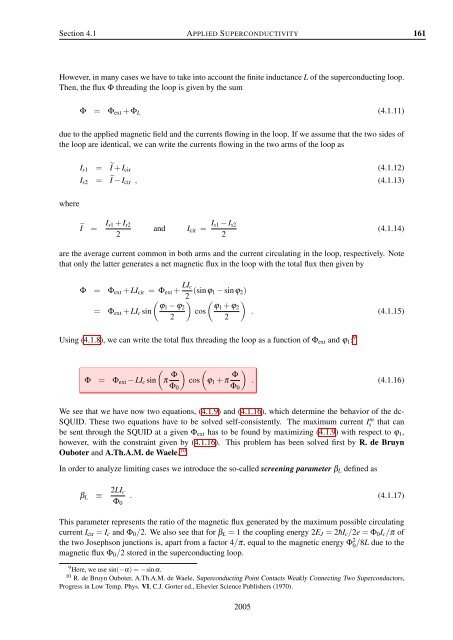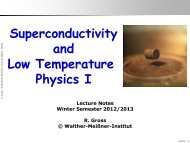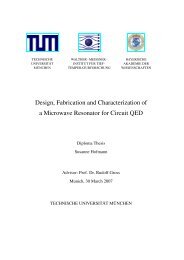Applied Superconductivity - Walther Meißner Institut - Bayerische ...
Applied Superconductivity - Walther Meißner Institut - Bayerische ...
Applied Superconductivity - Walther Meißner Institut - Bayerische ...
- No tags were found...
You also want an ePaper? Increase the reach of your titles
YUMPU automatically turns print PDFs into web optimized ePapers that Google loves.
Section 4.1 APPLIED SUPERCONDUCTIVITY 161However, in many cases we have to take into account the finite inductance L of the superconducting loop.Then, the flux Φ threading the loop is given by the sumΦ = Φ ext + Φ L (4.1.11)due to the applied magnetic field and the currents flowing in the loop. If we assume that the two sides ofthe loop are identical, we can write the currents flowing in the two arms of the loop aswhereI s1 = Ĩ + I cir (4.1.12)I s2 = Ĩ − I cir , (4.1.13)Ĩ = I s1 + I s22andI cir = I s1 − I s22(4.1.14)are the average current common in both arms and the current circulating in the loop, respectively. Notethat only the latter generates a net magnetic flux in the loop with the total flux then given byΦ = Φ ext + LI cir = Φ ext + LI c2 (sinϕ 1 − sinϕ 2 )( ) ( )ϕ1 − ϕ 2 ϕ1 + ϕ 2= Φ ext + LI c sincos22. (4.1.15)Using (4.1.8), we can write the total flux threading the loop as a function of Φ ext and ϕ 1 : 9Φ = Φ ext − LI c sin(π Φ )cos(ϕ 1 + π Φ )Φ 0 Φ 0. (4.1.16)We see that we have now two equations, (4.1.9) and (4.1.16), which determine the behavior of the dc-SQUID. These two equations have to be solved self-consistently. The maximum current Ism that canbe sent through the SQUID at a given Φ ext has to be found by maximizing (4.1.9) with respect to ϕ 1 ,however, with the constraint given by (4.1.16). This problem has been solved first by R. de BruynOuboter and A.Th.A.M. de Waele. 10In order to analyze limiting cases we introduce the so-called screening parameter β L defined asβ L ≡ 2LI cΦ 0. (4.1.17)This parameter represents the ratio of the magnetic flux generated by the maximum possible circulatingcurrent I cir = I c and Φ 0 /2. We also see that for β L = 1 the coupling energy 2E J = 2¯hI c /2e = Φ 0 I c /π ofthe two Josephson junctions is, apart from a factor 4/π, equal to the magnetic energy Φ 2 0 /8L due to themagnetic flux Φ 0 /2 stored in the superconducting loop.9 Here, we use sin(−α) = −sinα.10 R. de Bruyn Ouboter, A.Th.A.M. de Waele, Superconducting Point Contacts Weakly Connecting Two Superconductors,Progress in Low Temp. Phys. VI, C.J. Gorter ed., Elsevier Science Publishers (1970).2005
















